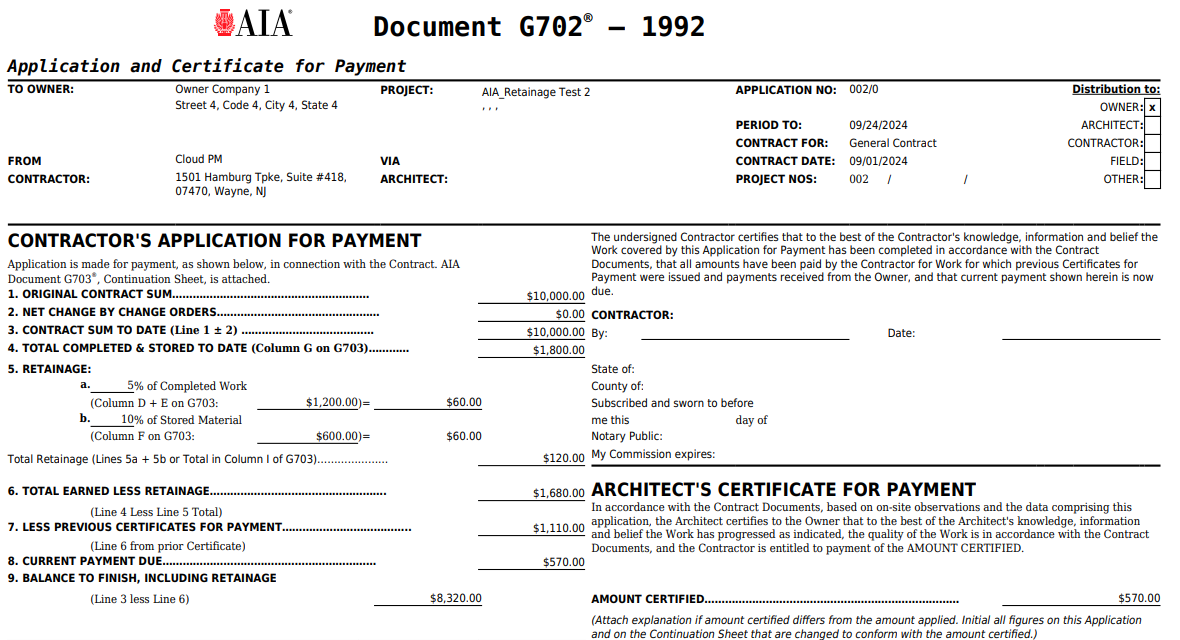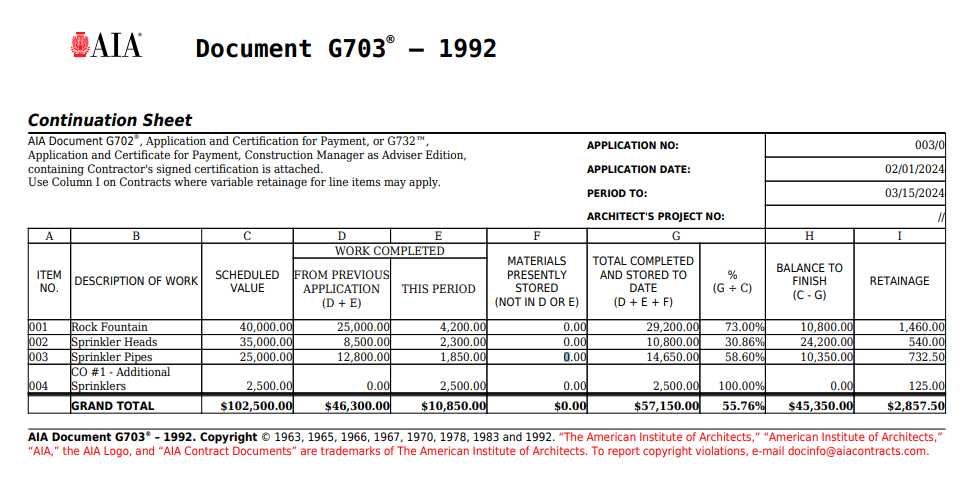By: Amanda Georgescu, Founder & CEO of Glazier Software
AIA billing refers to a standardized set of forms from the American Institute of Architects used to invoice for work completed on a project over time. They’re most common on commercial projects and are typically submitted monthly.
The two core forms are:
- G702 – Application and Certificate for Payment: Summarizes your current billing request.
- G703 – Continuation Sheet: Breaks down the job into line items and tracks how much of each has been completed to date.
Together, they:
- Provide a consistent format for billing
- Help general contractors review and aggregate subcontractor invoices
- Track retainage, stored materials, and percent complete
Step-by-Step: How to Set Up AIA Billing
1. Schedule of Values Comes from the GC
The Schedule of Values (SOV) is a breakdown of your contract amount by line item (e.g., Storefront Glazing, Doors & Hardware, Interior Glass, etc.).
Importantly, on AIA jobs, you don’t create the SOV—the general contractor provides it. You’ll receive this at project kickoff or contract signing.
Your job: bill against this schedule each month by entering your percent complete per line item.
2. Track Progress and Supporting Details
Since AIA billing is based on progress, it's critical to have accurate documentation to back up what you're billing.
Glazier helps you gather the right context during the billing period by:
- Pulling in received Purchase Orders tied to the job
- Surfacing labor hours tracked during the billing period
- Showing completion status by opening, using pin statuses and job data from the field
This makes it easier to justify your % complete claims and avoid pushback from the GC.
🧠 Instead of guessing at how much is done, Glazier gives you a clear picture based on real field data and procurement status.


3. Fill Out the G702 and G703 Forms
Using your progress data and the provided SOV:
- Enter percent complete for each line item (G703)
- Indicate any stored materials on site
- Apply retainage (typically 5–10%)
- Use G702 to summarize billing to date, amount due, and previous payments
Glazier customers can generate AIA-style billing outputs directly from tracked job data—eliminating manual spreadsheets or guesswork.
.avif)
4. Submit Monthly for Approval
AIA billing is submitted monthly—usually around the 25th to align with monthly draw schedules. Once submitted, the GC will review your progress claims, approve (or adjust), and pass it up the chain for payment.
Payments typically follow Net 30 or Net 45 terms after approval.
Common Mistakes to Avoid
- Billing without field or PO backup
- Misaligning your line items with the GC’s schedule of values
- Overstating % complete without documentation
- Forgetting to include stored materials
- Misapplying or ignoring retainage
How Glazier Helps
Glazier is built to support subcontractors doing complex commercial work—including AIA billing. Here’s how we streamline the process:
- Automatically pulls labor hours and PO delivery status for the billing period
- Shows progress by opening so you can confidently enter % complete
- Keeps job financials and field status in one place, so your office team doesn’t have to chase down updates
- Exports clean billing summaries to match your GC’s expectations
Real-World Impact: What Glass Companies Are Saying
Glass contractors using Glazier's AIA billing consistently report significant improvements in their commercial operations:
John Thompson, General Manager at Lee Glass and Window, found that Glazier's automated form generation eliminates the fragmented workflow his team previously faced. Instead of manually creating schedules of values, pay applications, and invoices across multiple systems, everything is generated automatically from the job data. Thompson estimates this saves his team 10-15 minutes per project on AIA billing, and when managing multiple commercial jobs simultaneously, these time savings compound significantly.
Andrea Elliott, Owner of Elliott Glass, credits Glazier's AIA billing capabilities as essential for growing their commercial portfolio. The streamlined process has allowed Elliott Glass to take on more commercial projects without adding administrative overhead, making it much easier to handle the complex billing requirements these jobs demand.
Dallas Miller from Lore L Ltd appreciates how change orders integrate seamlessly with AIA billing in Glazier. The simplified setup process allows his team to focus on project execution rather than paperwork management, with settings like retainage and billing dates configured with just a few clicks.
The Bottom Line: Glass contractors using Glazier's AIA billing consistently report the same benefits: significant time savings, reduced errors, and the confidence to pursue more commercial work. Instead of spending hours manually creating forms and chasing down project data, they're getting paid faster and growing their commercial portfolios.
Frequently Asked Questions (FAQ)
Q: What is AIA billing and when is it used?
A: AIA billing refers to a standardized set of forms from the American Institute of Architects used to invoice for work completed on a project over time. It's most common on commercial projects and is typically submitted monthly. The two core forms are G702 (Application and Certificate for Payment) and G703 (Continuation Sheet).
Q: Do I create the Schedule of Values for AIA jobs?
A: No, you don't create the Schedule of Values (SOV) on AIA jobs. The general contractor provides it to you at project kickoff or contract signing. Your job is to bill against this schedule each month by entering your percent complete per line item.
Q: How often should I submit AIA billing?
A: AIA billing is submitted monthly, usually around the 25th to align with monthly draw schedules. Once submitted, the GC will review your progress claims, approve (or adjust), and pass it up the chain for payment.
Q: What payment terms can I expect with AIA billing?
A: Payments typically follow Net 30 or Net 45 terms after approval by the general contractor.
Q: What's the typical retainage percentage on AIA jobs?
A: Retainage is typically 5-10% of the billed amount and is held until project completion to ensure work is completed according to contract terms.
Q: What documentation do I need to support my AIA billing?
A: Since AIA billing is based on progress, you need accurate documentation including received Purchase Orders tied to the job, labor hours tracked during the billing period, and completion status by opening using field data. This helps justify your percent complete claims and avoid pushback from the GC.
Q: What are the most common mistakes contractors make with AIA billing?
A: The most common mistakes include:
- Billing without field or PO backup
- Misaligning line items with the GC's schedule of values
- Overstating percent complete without documentation
- Forgetting to include stored materials
- Misapplying or ignoring retainage
Q: Can software help automate AIA billing?
A: Yes, glass management software like Glazier can automatically pull labor hours and PO delivery status for the billing period, show progress by opening so you can confidently enter percent complete, keep job financials and field status in one place, and export clean billing summaries to match your GC's expectations.
Q: How much time can I save with automated AIA billing?
A: According to glass contractors using Glazier, automated AIA billing can save 10-15 minutes per billing per project. When managing multiple commercial jobs simultaneously, these time savings compound significantly and allow teams to focus on project execution rather than paperwork management.
Q: Why is mastering AIA billing important for my business?
A: Mastering AIA billing is essential if you want to be paid in a timely manner.
Final Thoughts
Mastering AIA billing is a must if you want to be paid in a timely manner. The process might seem tedious at first, but with the right systems in place, it becomes a predictable routine and a faster path to getting paid.
Want help setting up AIA billing in Glazier? Book a free demo today with a product expert today.

